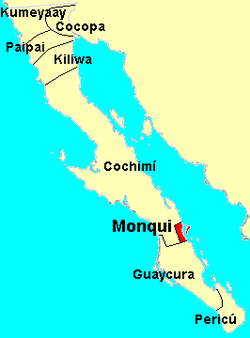Monqui

The Monquis were indigenous peoples in Mexico, who lived in the vicinity of Loreto, Baja California Sur, Mexico, at the time of Spanish contact. Probably first encountered by explorers traveling up the Gulf of California during the sixteenth century, they were subjected to some of the peninsula's earliest intensive Jesuit missionary efforts during the late seventeenth century. The Tyrolean Jesuit Eusebio Francisco Kino, together with Admiral Isidro Atondo y Antillón, unsuccessfully attempted to establish a mission at San Bruno on the northern margin of Monqui territory, in 1683-1685.[1] The first permanent mission in Baja California was founded at Loreto in 1697 by Juan María de Salvatierra.
Unfortunately, in contrast to many of their Jesuit colleagues, Kino and Salvatierra included relatively few notes on native ethnography in their letters and reports. Most of what is known about the aboriginal culture of the Monqui comes from incidental comments in explorers' accounts and at second hand in the works of the Jesuit historian Miguel Venegas (1757, 1979). The Monqui were hunter-gatherers who harvested a wide range of natural resources from the shores of the Gulf, as well as in interior valleys and the Sierra Giganta. They lacked agriculture, pottery, and metallurgy, and their social organization was evidently based on autonomous local communities that frequently fought one another. Traditional Monqui culture had probably disappeared before the end of the eighteenth century, under the impacts of mission acculturation and the decimation caused by Old World epidemic diseases.
Languages
The linguistic status of the Monqui is somewhat uncertain. William C. Massey (1949) thought that they had spoken a Cochimí language or dialect. A recent reassessment of the historical evidence suggests instead that their language was distinctive and non-Cochimí, possibly related to that of the Guaycura to the south.[2]
Notes
References
- Bolton, Herbert Eugene. 1936. The Rim of Christendom: A Biography of Eusebio Francisco Kino, Pacific Coast Pioneer. Macmillan, New York.
- Laylander, Don. 1997. "The linguistic prehistory of Baja California". In Contributions to the Linguistic Prehistory of Central and Baja California, edited by Gary S. Breschini and Trudy Haversat, pp. 1-94. Coyote Press, Salinas, California.
- Massey, William C. 1949. "Tribes and languages of Baja California". Southwestern Journal of Anthropology 5:272-307.
- Venegas, Miguel. 1757. Noticia de la California y de su conquista temporal, y espiritual hast el tiempo presente. 3 vols. M. Fernández, Madrid.
- Venegas, Miguel. 1979. Obras californianas del padre Miguel Venegas, S.J. Edited by W. Michael Mathes, Vivian C. Fisher, and Eligio Moisés Coronado. 5 vols. Universidad Autónoma de Baja California Sur, La Paz.